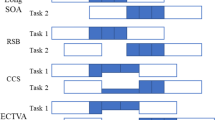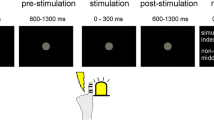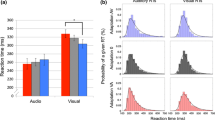Abstract
What are the consequences of visual and tactile neural processing time differences when combining multisensory information about an event on the body’s surface? Visual information about such events reaches the brain at a time that is independent of the location of the event. However, tactile information about such events takes different amounts of time to be processed depending on the distance between the stimulated surface and the brain. To investigate the consequences of these differences, we measured reaction times to touches and lights on different parts of the body and the perceived subjective simultaneity (PSS) for various combinations. The PSSs for pairs of stimuli were predicted by the differences in reaction times. When lights and touches were on different body parts (i.e. the hand and foot) a trend towards compensation for any processing time differences was found, such that simultaneity was veridically perceived. When stimuli were both on the foot, subjects perceived simultaneity when the light came on significantly earlier than the touch, despite similar processing times for these stimuli. When the stimuli were both on the hand, however, there was complete compensation for the significant processing time differences between the light and touch such that simultaneity was correctly perceived, a form of simultaneity constancy. To identify if there was a single simultaneity constancy mechanism or multiple parallel mechanisms, we altered the PSS of an auditory-visual stimulus pair and looked for effects on the PSS of a visual-touch pair. After repeated exposure to a light/sound pair with a fixed time lag between them, there was no effect on the PSS of a touch-light pair, suggesting multiple parallel simultaneity constancy mechanisms.






Similar content being viewed by others
References
Arrighi R, Alais D, Burr D (2005) Perceived timing of first- and second-order changes in vision and audition. Exp Brain Res (in press)
Bergenheim M, Johansson H, Granlund B, Pedersen J (1996) Experimental evidence for a sensory synchronization of sensory information to conscious experience. In: Hameroff SR, Kaszniak AW, Scott AC (eds) Towards a science of consciousness: the first Tucson discussions and debates. MIT Press, Cambridge, pp 301–310
Blake R, Sobel KV, James TW (2004) Neural synergy between kinetic vision and touch. Psychol Sci 15:397–402
Dassonville P (1995) Haptic localization and the internal representation of the hand in space. Exp Brain Res 106:434–448
Dennett DC, Kinsbourne M (1992) Time and the observer: the where and when of consciousness in the brain. Behav Brain Sci 15:183–201
Engel GR, Dougherty WG (1971) Visual-auditory distance constancy. Nature 234:308
Fujisaki W, Shimojo S, Kashino M, Nishida S (2004) Recalibration of audiovisual simultaneity. Nat Neurosci 7:773–778
Grossberg S, Grunewald A (1997) Cortical synchronization and perceptual framing. J Cogn Neurosci 9:117–132
Ivry RB, Spencer RM (2004) The neural representation of time. Curr Opin Neurobiol 14:225–32
Kopinska A, Harris LR (2004) Simultaneity constancy. Perception 33:1049–1060
Kopinska A, Harris LR, Lee I (2003) Comparing central and peripheral events: compensating for neural processing delays. J Vision 3:751a
Libet B (1991) Conscious vs neural time. Nature 352:27–28
Libet B (2004) Mind time: the temporal factor in consciousness. Harvard University Press, Cambridge
Libet B, Wright EW Jr, Feinstein B, Pearl DK (1979) Subjective referral of the timing for a conscious sensory experience: a functional role for the somatosensory specific projection system in man. Brain 102:193–224
Macefield G, Gandevia SC, Burke D (1989) Conduction velocities of muscle and cutaneous afferents in the upper and lower limbs of human subjects. Brain 112:1519–1532
Pandey PC, Kunov H, Abel SM (1986) Disruptive effects of auditory signal delay on speech perception with lipreading. J Aud Res 26:27–41
Pears S, Jackson SR (2004) Cognitive neuroscience: vision and touch are constant companions. Curr Biol 14:R349–R350
Pick HL, Warren DH, Hay JC (1969) Sensory conflict in judgements of spatial direction. Percept Psychophys 6:203–205
Spence C, Squire S (2003) Multisensory integration: maintaining the perception of synchrony. Curr Biol 13:R519–R521
Spence C, Shore DI, Klein RM (2001) Multisensory prior entry. J Exp Psychol Gen 130:799–832
Spence C, Baddeley R, Zampini M, James R, Shore DI (2003) Multisensory temporal order judgments: when two locations are better than one. Percept Psychophys 65:318–328
Stone RV, Hunkin NM, Porrill J, Wood R, Keeler V, Beanland M, Port M, Porter NR (2001) When is now? Perception and simultaneity. Proc R Soc Lond B 268:31–38
Sugita Y, Suzuki Y (2003) Audiovisual perception: implicit estimation of sound-arrival time. Nature 421:911
Von Békésy G (1963) Interaction of paired sensory stimuli and conduction in peripheral nerves. J Appl Physiol 18:1276–1284
Acknowledgements
These experiments were sponsored by the Natural Sciences and Engineering Research Council (NSERC) of Canada. We would like to thank Shamini Selvanayagarajah and Anisha Abreo for help in collecting some of these data.
Author information
Authors and Affiliations
Corresponding author
Rights and permissions
About this article
Cite this article
Harrar, V., Harris, L.R. Simultaneity constancy: detecting events with touch and vision. Exp Brain Res 166, 465–473 (2005). https://doi.org/10.1007/s00221-005-2386-7
Received:
Accepted:
Published:
Issue Date:
DOI: https://doi.org/10.1007/s00221-005-2386-7




